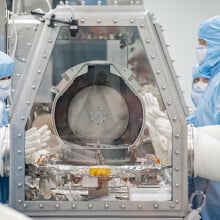A furious flood recently swept through Alaska's capital. A government camera, perched in the mountains above, filmed the cause.
In a world where most of the glaciers are melting and receding as the planet warms, lakes dammed up by glaciers can often form. These dams break from time to time, resulting in an event called a glacier lake outburst flood (GLOF). A section of Alaska's famed (though fast-receding) Mendenhall Glacier, called "Suicide Basin," has released these floods since 2011.
But this year, the discharge was especially intense, and most of the lake spilled out on August 5. Downstream, the Mendenhall River bulged, reaching its highest level on record. The swollen river became an emergency event as it violently pulled homes and buildings into the river.
The short footage below, captured by a U.S. Geological Survey camera above Suicide Basin, shows the glacial lake (layered with chunks of ice), rapidly draining during the outburst. The timelapse begins on May 18, 2023, and the lake fills through early August. Then, the lake level promptly drops.
In the drone video below, you can see some of the resulting collapsed structures — and some that have not yet fully collapsed into the river.
Tweet may have been deleted
Want more science and tech news delivered straight to your inbox? Sign up for Mashable's Light Speed newsletter today.
Alaska, like much of the greater Arctic, is experiencing profound environmental change. Yes, it's still frigid for much of the year because the region receives significantly less sunlight than lower-latitude places. This won't change. But, "Alaska is at the forefront of climate change," notes the U.S. Department of Agriculture. "Because of its northern latitude and seasonal changes in sea ice, the state is warming at two to three times the rate of the global average."
The consequences include increasingly severe heat waves and the boosted risk of extreme wildfires and floods.





























